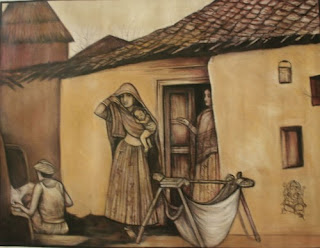Ghazipur
Village Life.....More Natural
Village is base of human civilization because first settlement of human beings is in village .People build big or small houses there. They Pugh their lands and grow cops. They grow crops not only for themselves. but also for those who live in other villages or towns. They keep cattle that provide meat,milk ,and other food items.We get many things from them.
Ghazipur , a district of Eastern
U.P. India ,with rich history and colorful culture, is spread along side of the
River Ganga,Gomti,and Beso. It is known for its stunning landscapes, customs
and traditions.
Ghazipuri’s love food, especially
spicy food, therefore restaurants and dhabas are found in abundance. Like the
culture a Ghazipuri wedding is also full of color and pleasure. It is a display
of beautiful clothes, expensive embroidery, heavy jewellery, songs, dance, and
not to forget the henna filled hands of the girls and bride.
Village is base of human civilization because first settlement of human beings is in village .People build big or small houses there. They Pugh their lands and grow cops. They grow crops not only for themselves. but also for those who live in other villages or towns. They keep cattle that provide meat,milk ,and other food items.We get many things from them.
There is pleasant environment.The surrounding is good for sight Flowing river
is good for swimming,drinking,cleaning,irrigation and also for beautiful
natural sight .people are innocent and they have simple living standards fresh
air and fresh vegetables are available there.Pure corns serve us as food
.Therefore,i believe that it is good to live in village.
Living standard of most families are very poor. Our large
population are below poverty life. They
have no good source of income except cultivation . There are no good doctors .
Neither there is other arrangement or treatment of the sick .No good facility
is of education the villages indulge in profitless activities and other
wasteful habits .They quarrel over petty matters and spend large sum of money
in litigation.
Villages consisted of a
population comprised of mostly of farmers. Houses, barns sheds, and animal pens
clustered around the center of the village, which was surrounded by plowed
fields and pastures. Society depended on the village for protection and a
majority of people during these centuries called a village home. Most were born,
toiled, married, had children and later died within the village, rarely
venturing beyond its boundaries.
Common enterprise was
the key to a village's survival. Some villages were temporary, and the society
would move on if the land proved infertile or weather made life too difficult.
Other villages continued to exist for centuries. Every village had a lord, even
if he didn't make it his permanent residence, and after the 1100's castles
often dominated the village landscape. Neighboring villages would parley to set boundaries that would be set
out in village charters.
Here peasants were
either classified as free men or as "villeins," those who owed heavy
labor service to a lord, were bound to the land, and subject to feudal dues.
Village life was busy for both classes, and for women as well as men. Much of
this harsh life was lived outdoors, wearing simple dress and subsisting on a
meager diet.
























No comments:
Post a Comment